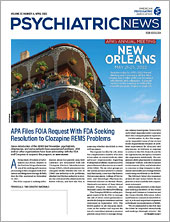The DSM-5 text revision (DSM-5-TR), released in March by APA Publishing, is the first published revision of DSM-5 since its original publication in 2013. Psychiatrists attending this year’s Annual Meeting in New Orleans can learn everything they need to know about this crucial text at a session titled “DSM-5-TR: What’s New and Why Clinicians Should Care.”
DSM-5-TR is a comprehensive update of the descriptive text accompanying each DSM disorder based on reviews of the literature since publication of DSM-5. But the new edition also includes a number of significant changes and improvements that are of interest to practicing clinicians. Among them:
•
Addition of diagnostic categories for prolonged grief disorder, stimulant-induced mild neurocognitive disorder, and unspecified mood disorder. (The absence of unspecified mood disorder from DSM-5 was an unintentional byproduct of the decision to eliminate the mood disorders diagnostic class from DSM-5 in favor of making bipolar disorders and depressive disorders top-level diagnostic classes.)
•
New symptom codes for reporting suicidal and nonsuicidal self-injurious behavior.
•
Modifications of the diagnostic criteria for over 70 disorders.
•
Updates in terminology (for instance, replacing “neuroleptic medications” with “antipsychotic medications or other dopamine receptor blocking agents” and changing “desired gender” to “experienced gender” in the text for gender dysphoria).
•
A new focus on how social determinants of mental health—including racism and discrimination—impact mental health in different communities and renewed attention to the use of nonstigmatizing language.
The session will be presented by DSM-5-TR Editor Michael First, M.D. He will describe the revision process and summarize the changes, highlighting those that are most clinically significant.
“DSM is widely regarded as the most authoritative source of information about most aspects of mental disorders except treatment,” First told Psychiatric News. “This information, encapsulated in the DSM text, is continually evolving. Consequently, it is crucial for the text to be kept up to date based on evolving psychiatric literature. DSM-5 text sections on ‘Risk and Prognostic Factors’ and ‘Diagnostic Markers’ contain information more susceptible to becoming outdated on the basis of scientific advances. Nine years have elapsed since publication of DSM-5 in 2013, longer than historical revisions to DSM after five to seven years.”
Most noteworthy is the addition of a new disorder, prolonged grief disorder. First said the addition is the result of years of research and clinical experience indicating that some people experience a pervasive inability to move past grief over the loss of a loved one and that these symptoms are severe enough to affect day-to-day functioning. It is estimated that following the nonviolent loss of a loved one, 1 in 10 bereaved adults is at risk for developing prolonged grief disorder, he said. ■
“DSM-5-TR: What’s New and Why Clinicians Should Care” will be held Saturday, May 21, from 10:30 a.m. to noon.

